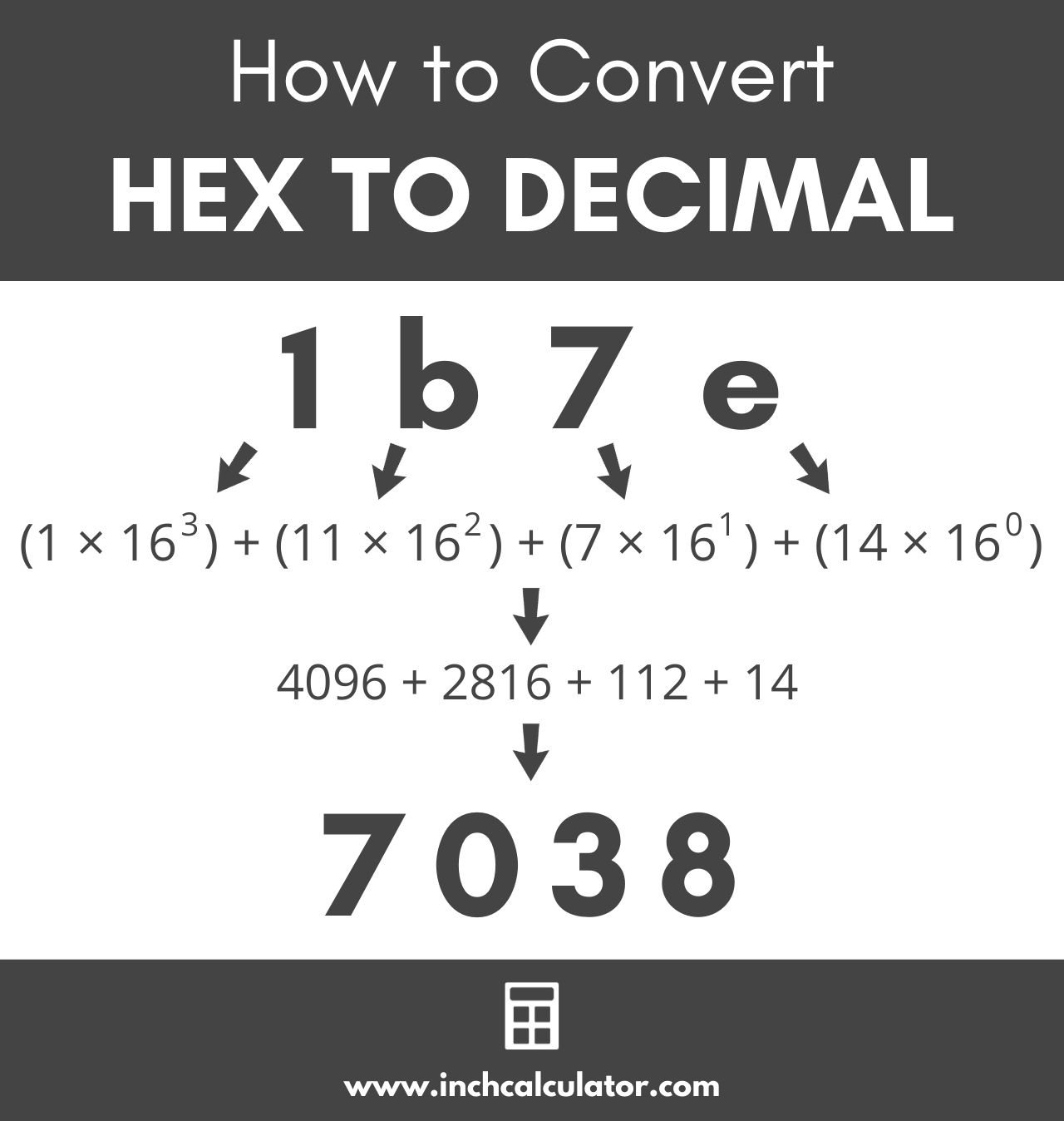Hexadecimal to Decimal Converter
Enter a hex number below to convert it to a decimal.
Decimal Number:
Steps to Convert to Decimal
On this page:
How to Convert Hex to Decimal
The hexadecimal number system is a base 16 number system. It uses 16 digits, 0 to 9 and a to f. On the other hand, the decimal number system is a base 10 number system that uses ten digits, 0 to 9.
Considering that the decimal system is most commonly used, you’ll often need to convert a hex number to its decimal value. Hexadecimal numbers are often used in software and networking applications.
To convert a hexadecimal number to a decimal, you can use the positional notation method. To use this method, multiply each digit in the hex number from the rightmost number to the left by 16 to the power of n, where n is the distance from the right.
So, reading the hex number from right to left, the furthest digit to the right is equal to the digit times 160. The digit that is one position from the right is equal to the digit times 161.
Hex to Decimal Formula
Thus, the hex to decimal formula is:
decimal number10 = (d0 × 160) + (d1 × 161) + … + (dn – 1 × 16n – 1)
In this formula, d0 is the hex digit furthest to the right, d1 is the digit one position from the right, and dn – 1 is the digit furthest to the left.

You can also use a tool like our hex calculator to convert to decimal or binary.
For example, let’s convert the hex number 1b7e to decimal.
decimal number10 = (1 × 163) + (11 × 162) + (7 × 161) + (14 × 160)
decimal number10 = 4096 + 2816 + 112 + 14
decimal number10 = 7038
How to Convert Fractional Hexadecimal Numbers to Decimal
For real hex numbers that contain fractional values, you can use the method above to convert as well, with a slightly different exponent value. Start by using the method above to convert the whole portion of the number from hex to decimal.
Then, for the remaining fractional value, multiply each number to the right of the decimal point by 16 to the power of -1 times the distance from the decimal point plus 1. That might seem complicated, but it’s easier than it sounds.
Let’s consider the implementation below:
decimal number10 = (d-1 × 16-1) + (d-2 × 16-2) + … + (d-n × 16-n)
For example, let’s convert the hex number 0.c3f to decimal.
decimal number10 = (12 × 16-1) + (3 × 16-2) + (15 × 16-3)
decimal number10 = (12 ÷ 161) + (3 ÷ 162) + (15 ÷ 163)
decimal number10 = 0.75 + 0.01171875 + 0.003662109375
decimal number10 = 0.765380859375
The calculator above can convert hex numbers to decimal, including fractional numbers like this one, along with negative numbers.
Hex to Decimal Conversion Table
The table below shows hexadecimal numbers and the equivalent decimal number values.
| Hexadecimal Number | Decimal Number |
|---|---|
| 0 | 0 |
| 1 | 1 |
| 2 | 2 |
| 3 | 3 |
| 4 | 4 |
| 5 | 5 |
| 6 | 6 |
| 7 | 7 |
| 8 | 8 |
| 9 | 9 |
| a | 10 |
| b | 11 |
| c | 12 |
| d | 13 |
| e | 14 |
| f | 15 |
| 10 | 16 |
| 11 | 17 |
| 12 | 18 |
| 13 | 19 |
| 14 | 20 |
| 15 | 21 |
| 16 | 22 |
| 17 | 23 |
| 18 | 24 |
| 19 | 25 |
| 1a | 26 |
| 1b | 27 |
| 1c | 28 |
| 1d | 29 |
| 1e | 30 |
| 1f | 31 |
| 20 | 32 |
| 40 | 64 |
| 80 | 128 |
| 100 | 256 |
| 200 | 512 |
| 400 | 1024 |
| 800 | 2048 |
You might also be interested in our hex calculator to add or subtract hex numbers.
Frequently Asked Questions
When would you convert from hex to decimal?
You would convert from hex to decimal when you need a more human-readable number or when using the number outside of a computer system, such as when performing mathematical operations with a standard calculator.
What is 16 hex to decimal?
16 hex to decimal is 22.
How do you know if a number is hexadecimal or decimal?
It would be difficult to differentiate numbers 0-9, however, after 9 in the hex system, the digits are a, b, c, d, e, and f that represent 10-15. In many cases, hex numbers are prefixed with “0x” to denote that the number is a hexadecimal.
For instance, “0x27” is a hexadecimal equal to 39 in decimal, while “27” is already in decimal form.


